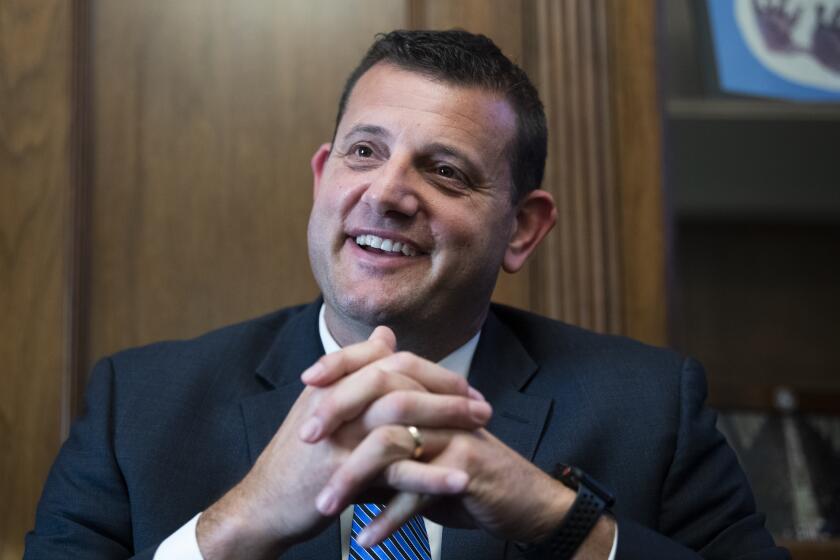Why is O.C. Republican Rep. Young Kim suddenly spending more than $1 million in her primary?

- Share via
GOP Rep. Young Kim of Orange County has all the elements for a fairly easy path to reelection in November — a gloomy national mood favoring her party, a formidable campaign war chest and a new, more Republican-friendly district. Most prognosticators considered her June 7 primary to be an afterthought.
But now she is campaigning with a sudden sense of urgency. Kim has unleashed $1.3 million in advertising as the primary approaches. Outside allies are coming to her aid with more spending.
Most of Kim’s focus is on fending off Greg Raths, an underfunded GOP opponent who has been a staple on the political scene in Mission Viejo, the district’s largest city. After years of touting her bipartisan bona fides, she is upping her appeals to the GOP base, emphasizing her conservatism and hard-edged rhetoric on illegal immigration.
The explosion in spending may just be a cautionary measure, or a sign of a suddenly rattled front-runner. More broadly, Kim’s tilt further to the right reflects redistricting’s influence on politicians. With a shift in district boundaries, Kim’s campaign style has shifted too — vying for a constituency that is more conservative and less diverse than the residents she now represents.
“We think she is the heavy favorite to win reelection, but you can’t win re-election if you don’t make it through the primary first,” said Nathan Gonzales, editor and publisher of Inside Elections, which provides nonpartisan campaign analysis. “I don’t think campaigns make these sort of moves unless there is a concern she isn’t going to make the top two.”
California’s 2022 primary election ballot includes races for governor, attorney general, the Legislature and Congress, as well as local contests.
Kim still enjoys the powerful benefits of incumbency. If, in a huge upset, she fails to advance, the implications could reverberate in the national battle for control of the House. The sole Democratic candidate, physician Asif Mahmood, would have improved chances of turning the seat blue, a rare pickup opportunity in a cycle where his party is largely on defense.
Kim’s campaign portrayed the moves as due diligence that was long expected, particularly because she must introduce herself to 80% of the district’s voters.
“We don’t take anything for granted as Congresswoman Kim takes every campaign seriously,” said Sam Oh, a Kim campaign strategist. “She’s working hard to earn every vote.”
The first hints of a changing campaign dynamic came earlier this month, in a text message from Kim linking Raths, a Mission Viejo city councilman, to President Biden, blaming them both for illegal immigration. “We CANNOT risk the Raths-Biden agenda,” it read.
Since then, her advertisements have continued to pile on Raths, showing his photo with House Speaker Nancy Pelosi and accusing him of being liberal.
Rep. David Valadao (R-Hanford) infuriated Central Valley conservatives when he voted to impeach Trump. But Trump is silent on Valadao’s reelection bid.
That’s an unlikely label for the 68-year-old retired military colonel who is a devoted fan of former President Trump and the Freedom Caucus, a group of far-right Republicans in Congress. If the GOP takes the House, his choice for speaker would be Rep. Jim Jordan of Ohio, a conservative firebrand, over House Minority Leader Kevin McCarthy, a fellow Californian.
Raths was largely dismissed by political observers in his challenge against Kim, who had the backing of the Republican establishment and raised nearly $5 million as of March compared with Raths’ $100,000. Another Republican in the race, Nick Taurus, a right-wing extremist who has aligned himself with white nationalists, brought in less than $10,000.
But Raths does have an advantage of familiarity, especially among faithful Republican voters. He’s appeared on their ballots multiple times in his city council runs. He also ran for Congress three times, most recently losing to Democratic Rep. Katie Porter in 2020.

After the decennial redistricting process set off a musical chairs among incumbents to compete in redrawn districts, Kim, 59, declared she’d run in the new 40th District. The predominantly inland Orange County swath includes Aliso Viejo and Rancho Santa Margarita. Her residence in La Habra sits just west of the boundaries (members of Congress are not required to live in their districts).
While a majority of eligible voters in Kim’s current district are people of color (30% Asian American and 29% Latino), the new district has fewer minority voters and is nearly 61% white, according to the nonpartisan California Target Book, which handicaps races.
In previous races, Kim faced an uphill battle against a 5-point Democratic registration advantage. Biden easily beat Trump in that district by 10 percentage points in 2020. To win, she had to appeal to cross-over voters — and she did so by emphasizing her moderate politics and making little mention of Trump. Her congressional website touts that she was recently rated the most bipartisan freshman member of Congress and among the top 10 most bipartisan Republican members.
In her unsuccessful run for Congress in 2018, she struck a moderate tone on immigration, emphasizing her support for a pathway to citizenship for “Dreamers” who were brought to the country illegally as children and opposing Trump’s policy of family separation at the border.
Now, running in redder territory — Republicans hold a 5-point registration advantage in the new district — her ads tell voters to “Vote Conservative. Vote Kim.” The immigration-focused text message sent by her campaign touts her support for securing the border, including “Keeping Trump’s Remain in Mexico policy.”
“We’re highlighting her positions that the voters in this district care about that are timely and at the forefront of their minds,” said Oh, the campaign strategist. “It’s as simple as that.’
But Kim’s attempts to out-flank Raths on the right may ring false with some voters.
“That’s crazy,” said Nancy Sandoval, 78, a Raths supporter and Mission Viejo resident who runs a website that offers voting advice for conservatives. “I know his heart. He certainly isn’t a liberal.”
Unable to afford television advertising, Raths has put his faith in what he called “an amazing stealth ground game.” He said his campaign has visited 70,000 houses in the district since February. Walking 12 miles a day, Raths said, he’s lost 27 pounds. He would also campaign while working as an Uber driver, pitching his candidacy to passengers.
Some Republicans worry he would be a flawed general election candidate. In 2020, he joined a lawsuit alleging the California election was rife with fraud, echoing Trump’s false election claims; the suit was thrown out by a federal judge. Fox News reported in April that his campaign website copied several passages nearly word-for-word from South Carolina Sen. Lindsey Graham’s site. And this month, he said at a candidate forum that the Jewish community “control[s] a lot of politicians.”
The Supreme Court’s expected reversal of Roe vs. Wade may sway college-educated women’s votes in key congressional races in places like Orange County.
Kim’s sudden advertising onslaught against Raths has made others take notice. The Cook Political Report, which does nonpartisan elections analysis, noted that “GOP strategists believe Kim was slow to take Raths seriously” and rated the seat as “lean Republican,” down from the stronger “likely Republican” it had initially assessed.
Meanwhile, Mahmood, the Democrat, has spent more than $400,000 on air attacking Raths for being too conservative on abortion, indirectly boosting Raths’ appeal among the GOP base. The ad does not mention Kim at all.
“We’ll be prepared in the general for whoever emerges, but right now it looks more likely to be Raths,” said Nathan Click, a Mahmood campaign strategist.
Political gamesmanship is also likely at play. There is a long tradition of candidates trying to elevate an opponent in the primary whom they see as more beatable in November. Kim’s allies accused Democrats of “disinformation” by trying to publicize Raths.
The Republican state party has sent mailers trumpeting Kim and has staff in her district working on contacting voters. Reinforcement also came from Congressional Leadership Fund, a McCarthy-aligned super PAC that plowed more than $650,000 into television and radio ads for the final days of the primary.
“This would be the equivalent of taking your shoe and crushing an ant in terms of political heft,” said Jon Fleischman, a GOP strategist. “Why not use it?... If she can stomp out her opponents in a pretty meaningful way, it is a deterrent to this happening again in two years.”
Raths’ resources are minuscule by comparison. He’s spent less than $10,000 on radio ads and has sent out texts highlighting Kim’s vote to censure Trump after the insurrection. Still, his ground game and indirect advertising from Mahmood gave him enough hope to put up $90,000 of his own money.
“We’ll see in two weeks if that was a good bet,” he said.
More to Read
Get the L.A. Times Politics newsletter
Deeply reported insights into legislation, politics and policy from Sacramento, Washington and beyond. In your inbox twice per week.
You may occasionally receive promotional content from the Los Angeles Times.














